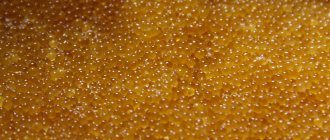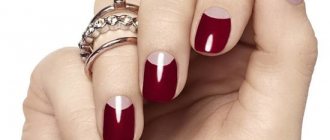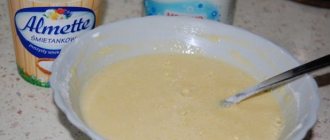Good day to all!
Please tell me, is there any way to reduce the saltiness of red caviar? Maybe fill it with something.
And maybe, who knows recipes involving this delicacy?
“How to revive not very successful caviar. But what to do if the taste of caviar leaves much to be desired, and it’s a shame to throw it away? You can try to “reanimate” her.
1. Place the over-salted caviar in a vessel and fill it with the same or twice as much warm (25 - 30 degrees) boiled water. Stirring lightly, let stand for about 3 to 7 minutes. This can be established experimentally. If you overcook, the caviar will turn out almost fresh. There is no need to get carried away. Pour it all into cheesecloth or a small sieve. Let it drain for 10-15 minutes. You can eat.
2. If the caviar has acquired an unpleasant taste, is sour (but not completely rotten) - it can be washed in the same way, but instead of water, use regular tea leaves.
3. In some cases, boiled or pasteurized milk is used. This is when the caviar is completely gone. Sometimes it helps. But naturally the caviar is no longer the same. So try to take a quality one.
Good day to all!
Please tell me, is there any way to reduce the saltiness of red caviar? Maybe fill it with something.
And maybe, who knows recipes involving this delicacy?
“How to revive not very successful caviar. But what to do if the taste of caviar leaves much to be desired, and it’s a shame to throw it away? You can try to “reanimate” her.
1. Place the over-salted caviar in a vessel and fill it with the same or twice as much warm (25 - 30 degrees) boiled water. Stirring lightly, let stand for about 3 to 7 minutes. This can be established experimentally. If you overcook, the caviar will turn out almost fresh. There is no need to get carried away. Pour it all into cheesecloth or a small sieve. Let it drain for 10-15 minutes. You can eat.
2. If the caviar has acquired an unpleasant taste, is sour (but not completely rotten) - it can be washed in the same way, but instead of water, use regular tea leaves.
3. In some cases, boiled or pasteurized milk is used. This is when the caviar is completely gone. Sometimes it helps. But naturally the caviar is no longer the same. So try to take a quality one.
If the caviar is of high quality, it should be large, and all eggs should be the same size. They should also not stick together and burst freely in the mouth. High-quality caviar should be thick and have a pleasant smell. What to do if suddenly the caviar seems stale and has an unpleasant odor? You can try to restore it to its former freshness. In addition, this impression can also be caused by excess salt.
What to do with excess salt in caviar?
Caviar can be over-salted, but don't worry—there's one proven method to fix it. You should place the caviar in a large bowl, then fill it with water at room temperature, at a ratio of two to one. Stir slowly for a couple of minutes to remove excess salt from the caviar. Then you need to get rid of the water by straining the product using gauze or a sieve. After this, place the caviar on a plate and leave it indoors for about 10 minutes. After this time, the product can be served or transferred to a jar and closed with a lid. Under no circumstances should you wash such a delicacy in very hot water so that the protein in the eggs does not curdle.
In a jar or by weight
Caviar not packaged in jars can be stored for no more than 4 months. Salmon spawning and fishing takes place in July-August. This means that you need to buy loose caviar before November. After that it is no longer of good quality. Often, unscrupulous sellers (who most likely purchased caviar from poachers) freeze it. And such caviar may taste quite decent and smell good, but after freezing it loses most of its beneficial properties.
So after November it is better to purchase caviar in factory jars. It lasts in them for a year.
What to look for when choosing caviar in a jar
- The jar must have the date of manufacture on it. Caviar should be rolled into jars within a month after catching, no later. That is, July or August must be indicated on the jars.
- A mandatory mark on the jar is GOST or TU (technical specifications) according to which the caviar is made. It is better to choose jars made in accordance with GOST: this is the caviar that is packaged in jars after a month, is not frozen before that, antiseptics and glycerin are added to it so that the caviar does not dry out - only three E-additives.
- The jar should not be swollen - this is a sign of spoiled caviar.
- the numbers on the lid of the tin must be pressed from the inside
- The jar should be shaken, the caviar inside should not rattle, but it should be felt that it is moving, this means that the product has not dried out and its quantity is optimal.
Shop or market? Where they sell safe red caviar Read more
When buying caviar by weight
- Smell it. The caviar should smell faintly of fish. A strong fishy smell is a sign of artificial caviar, for the production of which fragrances were used.
- Look at her. The eggs should be unbruised, smooth, shiny, and free of blood clots.
- A color that is too dark or too light are signs of a poor quality, damaged or overripe game.
- Give it a try. Strong bitterness and unpleasant aftertaste are unacceptable. A very hard shell indicates that the caviar is overripe.
Unpleasant smell
If caviar has not only excess salt, but also an unpleasant odor, you can get rid of it in this way: you need to brew strong tea, strain it (separate it completely from unnecessary tea leaves). The remaining tea leaves can be thrown away; you will no longer need them. The brewing temperature should not be high, a maximum of 30-35 degrees, so as not to cook the caviar.
If the smell is very strong, then you should pour the product with tea leaves in a ratio of 1/2, and if it is more or less acceptable, then in a ratio of 1/1. Slowly wash the caviar from foreign odor for 5-7 minutes, while stirring it so that the eggs remain intact. Place the caviar on cheesecloth or a sieve for a while to allow the liquid to drain. When it has completely drained, check the caviar for taste. Make sure you have washed the product well; if so, you can safely serve it. If excess salt still remains in the caviar, then you should carry out the washing process again.
If the caviar is stale
In addition, it also happens that caviar becomes over-salted because it sits for too long. In this case, the product can be saved with boiled milk. To do this, you just need to boil it, but the degree should not exceed 40. Place caviar in it and rinse for 10-12 minutes. Repeat the same as with water - drain the milk through cheesecloth, leave the caviar on it over a bowl and let the remaining liquid drain. When the caviar is free of unnecessary impurities, it can be served.
Quote from Irimed's message
How to fix red caviar.
Master class Author's text: “Not long ago I encountered a problem - my husband bought caviar, and not only did it turn out to be too salty, but it also tasted mediocre, the caviar was crushed... In general, half a kilo, it’s a pity to throw it away, there’s a reluctance. I began to think about how to correct the situation, I heard that it could be washed, but how, what? After a short search, I found an acceptable way, I decided - I’ll take the risk, if it doesn’t work out, then “into the furnace!” I did everything according to the instructions, the result simply shocked me! The taste has improved, the excess salt has gone, and most importantly, caviar to caviar! I understood how unscrupulous manufacturers and marketers can improve the appearance and taste of a product, so that it would never even cross my mind to doubt its quality. In short, I propose a proven, “tested on dogs” method of correcting red caviar, in case it comes in handy.
Red caviar is a favorite delicacy on holiday tables. It is not only very tasty, but also healthy. Good, high-quality caviar should consist of large eggs of the same size and color, which do not stick together, easily crumble and burst easily on the teeth. It should be thick and smell good. But what to do if the caviar you get is a little stale, has a foreign smell, or is simply too salty? Since the product is quite expensive, it’s a shame to throw it away. You can try to revive the caviar.

You will need: water, tea leaves, gauze, a sieve and two deep containers.
Instructions 1 If the caviar is over-salted, then this can be easily corrected! You can make it tasty by washing it as follows. Place the caviar in a deep bowl. Fill it with warm boiled water (not hotter than 35 degrees) at the rate of 2 parts water to one part caviar. Gently stir in the water for 3-4 minutes so that unnecessary salt goes into the water. Pour the caviar and water to strain through cheesecloth or a fine sieve over a sink or saucepan. Leave on a sieve or gauze for 10 minutes to drain off any unnecessary liquid. Place the caviar in a vase or saucer. It is ready to eat. 2 Caviar that has a foreign odor can be removed. Brew strong tea leaves in any container. Strain the brewed liquid, separating it from the tea leaves. The tea leaves are not needed, throw them away. The brewing temperature should be no more than 30-35 degrees so that the caviar simply does not cook in it.
Elimination of salt and odor
To wash off excess salt from red caviar, place it in a deep bowl and fill it with warm boiled water, the volume of which should be twice the amount of the product. Gently stir the caviar for 3-4 minutes, wait until the salt dissolves, then drain the water through cheesecloth or a sieve into the sink and wait another 10 minutes until the remaining liquid has completely drained. Then place the washed caviar on a saucer and eat - after these manipulations it will lose its salty taste.
If the purchased red caviar has a foreign odor, brew strong tea leaves in any container and strain it so that no, even the smallest, tea leaves remain in the liquid.
Red caviar smells like hydrogen sulfide

Knowing the basic rules when choosing it will help you buy high-quality, healthy red caviar for your New Year’s table.
The head of the Association of Fishermen of Ukraine, Alexander Chesnokov, told a GolosUA correspondent about this.
A. Chesnokov recommended that when choosing red caviar for the New Year's table, choose caviar in glass rather than metal containers.
“It is better to buy caviar in a glass jar rather than in a metal container. Transparent glass allows you to see the color, size and quality of the grain. If the caviar looks like it is covered in frost, it is fake. In addition, glass containers are chemically neutral and there is no oxidation process,” the expert explained.
A. Chistyakov emphasized that when purchasing a loose product, pay attention to the friability of the grain.
“The eggs should be easily separated from each other and not stick to the shoulder blade. If the caviar looks more like a sticky, shapeless mass, go to another store. Before purchasing, be sure to ask the seller when the container was opened. Caviar is mainly supplied by weight in plastic containers ranging from 0.5 to 5 kg. This is a perishable product; after opening the container, its shelf life is 24 hours. To extend its shelf life, unscrupulous sellers add formaldehyde-based emulsifiers to caviar. A useful product after such manipulations can become hazardous to health,” said the head of the Ukrainian Fishermen’s Association.
He recommends that when buying caviar by weight not in a large hypermarket, you should take into account that sellers often set themselves the task of refreshing an expired product. To do this, use potassium permanganate, vegetable oils, ascorbic acid, and mineral water. You need to take a few eggs and feel them with your fingers. If oil was used, you will feel how they slide and notice the shine characteristic of oil.
The head of the Fishermen's Association explained that the sharp bitter taste of red caviar may indicate improper use of preservatives. It is better not to consume such caviar. Food additive E-239 is a toxic preservative called urotropine, which is hazardous to health. When using preservatives E-200 and E-211, the product is considered safer. The concentration of each preservative should not exceed 0.1%.
“If caviar contains flavoring additives and dyes, it should be treated with double caution, since these substances are mainly used to hide any imperfections. Artificial caviar is usually made from gelatin or algae, is very elastic, and, if you look closely, it does not have a core - it is monochromatic.
The shades of red caviar directly depend on the type of fish,” he clarified.
According to A. Chistyakov, the most delicious caviar is chum salmon. Its color is orange with a red glow, the eggs are quite small, the film is thin and elastic. If the caviar is completely pale or yellow, it means it is overripe and has lost its taste. Second place goes to pink salmon. Its eggs are orange and light orange. Dark red sockeye salmon caviar received “bronze” from our consumers for its unique taste, but Europeans, on the contrary, consider it the best.
“High-quality red caviar smells slightly like fresh fish. In artificial caviar, herring milk is used as a flavoring agent, so a strong fishy smell gives away the fake. It tastes tough and very salty. If you are in doubt about what kind of caviar you bought - real or artificial, conduct a simple experiment. Throw 2-3 eggs into a glass of hot water: the artificial caviar will dissolve in boiling water. Keep the opened jar in the refrigerator for no longer than 4-5 days. Do not put it in the freezer under any circumstances, otherwise the grains will burst and turn into puree. Good quality caviar has a uniform color and is not oversalted. The eggs should not be burst, stuck together, dried out or without a shell,” the expert noted.
A. Chistyakov emphasized that the main signs of the quality of red caviar are as follows. The manufacturing date marking on the lid is pressed in from the inside, rather than lasered onto the lid or punched into paper. You should choose first-class caviar. This is a guarantee that the jar contains caviar of only one type of fish, all eggs are approximately the same diameter, without damage and elastic. The amount of salt should not exceed 4-6%. Caviar is a highly perishable food product. Ideal storage conditions are from minus 2 to minus 6 degrees. To reduce drying out of caviar, always keep it in a closed container. You can also add a thin layer of vegetable oil to enhance protection. The difference in price of different types of caviar is explained not by the difference in their nutritional and taste properties (they are approximately the same), but by the difficulty of extraction. For example, black caviar is more expensive than red caviar only because there is less of it in nature. Sturgeon are more difficult to catch; they can produce caviar only when they reach 10 years of age. And golden royal caviar (has an amber color) is obtained from sturgeon over 60 years old.
Liveinternetliveinternet
Sun,·06·03·05On the forum: Sun,·30·08·15Thanks:
Rating: 21 Quote(Utro-na-More @ Tuesday, 13·05·2008, 23:41) hmm. guys, we had the same story. True, the scent was not strong and the taste was absolutely normal, but see Lilia’s post... However, either the toad strangled it, or they were just lazy and left the jars standing on the balcony (it was cold). And strangely enough, after a while the smell disappeared, and the caviar just became a little saltier Fork, you were in a hurry to throw it away)) Starfish Friday, 05/16/2008, 11:38 Message #8 Profile options: Very active memberGroup: Regular memberMessages: 1584Registration : Tue,·14·03·06On the forum: Fri,·20·11·15From: Brussels, BelgiumThanks:
Rating: 5 Quote (Taty @ Friday, 16·05·2008, 10:33) Fork, you were in a hurry to throw it away)) As far as I know, you can still revive it: you need to rinse it carefully, and then mix it with oil and salt.
How to remove excess salt from over-salted red caviar?
Red caviar has suffocated. Is it possible to revive it? Fork Monday, 12·05·2008, 19:14 Message #1 Profile options: HappyGroup: Regular memberMessages: 3363Registration: Fri,·16·09·05On the forum: Sat,·13·01·18From: SPbThanks:
Rating: 4 An uncle from the Far East gave me through relatives a fairly large jar of salted red caviar. Relatives kept her for a day not in the refrigerator but outside the window. Yeah at +25 just yesterday. Today we took the caviar from them, opened it and it had a smell, and such a decent smell.
The taste (I tried one egg at my own risk) is not bitter. The bank was closed. We sit and think about whether the caviar can be saved...
What to do if red caviar is too salty?
Read in full In your quotation book or community! How to fix red caviar. Master class Author: Kisulya Author's text: “Not so long ago I ran into a problem - my husband bought caviar, and not only did it turn out to be too salty, but it also tasted mediocre, the caviar was crushed... In general, half a kilo, it’s a shame to throw it away, there’s reluctance. I began to think about how to correct the situation, I heard that it could be washed, but how, what? After a short search, I found an acceptable way, I decided - I’ll take the risk, if it doesn’t work out, then “into the furnace!” I did everything according to the instructions, the result simply shocked me! The taste has improved, the excess salt has gone, and most importantly, caviar to caviar! I understood how unscrupulous manufacturers and marketers can improve the appearance and taste of a product, so that it would never even cross my mind to doubt its quality.
How can you tell if red or black caviar has gone bad?
Attention
The beneficial effects of red caviar are good for kidney function, strengthening bones, the nervous system, and increasing hemoglobin. This product is useful for mental stress. Like all seafood, caviar contains large amounts of iodine. Therefore, it is recommended for thyroid health.
Such an abundance of beneficial properties does not mean, however, that red caviar cannot be harmful to health. It should be remembered that red caviar is contraindicated for ischemia, kidney diseases, hypertension, excess weight, as well as for children under 3 years of age. Caviar helps retain fluid in the body, as it contains a large amount of salt.
In addition, this product may cause allergies. If you buy spoiled red caviar, the consequences can be serious. So let's figure out how to avoid such problems.
How to revive over-salted red caviar
Place the caviar in a vase or saucer. It is ready for use.2 Caviar that has a foreign odor can be removed. Brew strong tea leaves in any container. Strain the brewed liquid, separating it from the tea leaves. The tea leaves are not needed, throw them away. The brewing temperature should be no more than 30-35 degrees so that the caviar simply does not cook in it.
Pour the strained tea over the caviar at the rate of one part caviar to one part brewed tea, or one part caviar to two parts tea, depending on how strong the smell is. Rinse in the tea leaves for 5-7 minutes, stirring gently so that the eggs do not burst. Strain the caviar through cheesecloth or a sieve and let it drain. There is not enough evil, such a product was ruined in a day. Threw it out of course... Utro-na-More Tuesday, 13·05·2008, 23:41 Message #6 Profile options: Very active memberGroup: Regular memberMessages: 2655Registration: Tue,·07·12·04On the forum: Sun,·21·09 ·14From: MoscowThanks:
Awards: 5Rating: 18 hmm. guys, we had the same story. True, the scent was not strong and the taste was absolutely normal, but see Lilia’s post... However, either the toad strangled it, or they were just lazy and left the jars on the balcony (it was cold). And oddly enough, after a while the smell disappeared, and the caviar just became a little saltier.
They ate it all! (although I didn’t – I can’t stand too much salt). And my relatives also say that when we sent them parcels with caviar from Magadan, the caviar rarely arrived without a flavor. And they always ate everything and that - it’s not us, spoiled northerners.
Not a guide to action(!), just a fact. Or throw it away without risk? liliya Monday, 12·05·2008, 20:06 Message #2 Profile options: Very active participantGroup: SupermoderatorMessages: 1959Registration: Wed,·17·11·04On the forum: Sat,·28·01·17From: Italia, MilanoThanks:
Rating: 21 Throw it away. Violation of food storage conditions results in a sharp increase in pathogenic bacteria, the waste products of which emit this unpleasant odor. You can be seriously poisoned. I wouldn't risk it, it's not worth the trouble. restorer zlata Tuesday, 05/13/2008, 11:16 Message #3 Profile options: thing-in-itselfGroup: SupermoderatorMessages: 2388Registration: Thu, 07/14/05Forum: Thu, 11/30/17From: Blagoveshchensk, Amur region. Acknowledgments:
Awards: 3Rating: 45 Just for the future. Caviar can be frozen for long-term storage.
Pack in small containers - you can eat as much as you want at a time and store in the freezer.
If you oversalt red caviar
Manufacturers often over-salt caviar so that its poor quality is not noticeable. If this doesn’t bother you, or it’s of high quality, but just heavily salted, then the situation can be corrected.
You can wash it in the same way as salted fish, in milk. Milk takes away the unpleasant odor and washes away the salt. In this case, however, the presentation is lost and the color of the eggs changes.
It is better to rinse the caviar (in portions - only the one you are going to eat at the moment) with ordinary cold boiled or still mineral water.
To do this, pour a portion of red caviar with water, stir gently and drain the water through a sieve. Can be repeated a couple of times.
The finished caviar can be slightly “buttered”, i.e. sprinkle with vegetable oil.
It becomes significantly less salty.
To remove excess salt from red caviar, you do not need to wash it in water. And the idea of soaking caviar, like a herring, in milk, can only be a nightmare for a person who understands the principles of cooking.
If caviar is too salty, this does not mean that it was deliberately over-salted, because it was of poor quality to begin with. Maybe they just over-salted it when salting it.
If this is the case, then briefly washing the eggs in cold water will not remove excess salt - it is firmly absorbed into each egg. And the more you wash the caviar with water, the more beneficial substances will be washed out of the caviar. In addition, caviar will absorb water, which will not definitely improve its taste - it’s better to eat it salted on bread and butter.
However, there is one good way to remove excess salt from caviar. Transfer the caviar to plastic and place in the freezer for a week. During this time, the salt crystallizes onto the surface of the eggs. Now defrost the caviar in the plus chamber of the refrigerator, place it in a glass container and fill it so that just the surface is covered with medium-strength tea without sugar (make sure there are no tea leaves) and mix well. After ten minutes, drain the tea - the caviar will become lightly salted - all the excess salt will leave the caviar.
You can return caviar if it is salted
Then defrost at room temperature. It will be as fresh. Taty Tuesday, 13·05·2008, 12:23 Message #4 Profile options: I live hereGroup: Regular participantMessages: 3490Registration: Sun,·06·03·05On the forum: Sun,·30·08·15Thanks:
Rating: 21 Quote(zlata @ Tuesday, 13·05·2008, 11:16) Caviar for long-term storage can be frozen PPKS was handed to me from the Danish East - frozen. defrosted - the caviar has not lost its qualities Message edited by Taty - Tuesday, 05/13/2008, 12:24 Fork Tuesday, 05/13/2008, 13:48 Message #5 Profile options: HappyGroup: Regular memberMessages: 3363Registration: Fri,· 16·09·05On the forum: Sat,·13·01·18From: St. Petersburg Thanks:
Rating: 4 Quote(zlata @ Tuesday, 13·05·2008, 11:16) Caviar can be frozen for long-term storage. I know. This is exactly how I store it for half a year. My relatives didn’t know this and threw me out the window.









